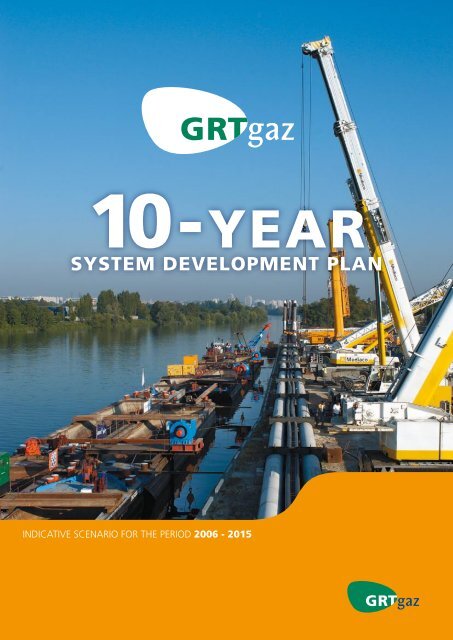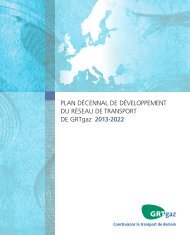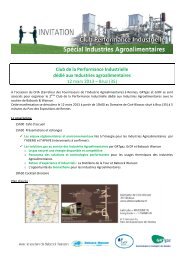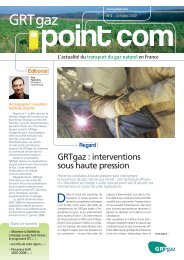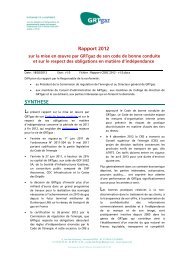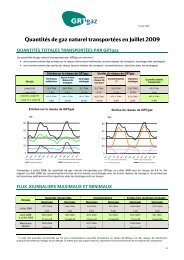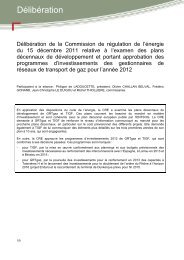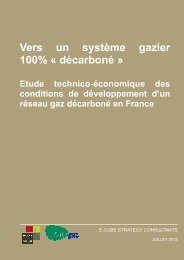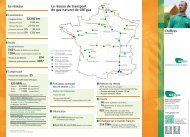10-yearsystem development plan indicative scenario - GRTgaz
10-yearsystem development plan indicative scenario - GRTgaz
10-yearsystem development plan indicative scenario - GRTgaz
- No tags were found...
You also want an ePaper? Increase the reach of your titles
YUMPU automatically turns print PDFs into web optimized ePapers that Google loves.
<strong>10</strong>-YEARSYSTEM DEVELOPMENT PLANINDICATIVE SCENARIO FOR THE PERIOD 2006 - 2015
EDITORIAL<strong>GRTgaz</strong> is in charge of one of Europe’s largest gas transmission systems. Withmore than 31,600 km of pipelines and transmission levels in 2005 in excess of 700 TWh,we offer a transportation service to all shippers wishing to enter the French market.Our role naturally leads us to work towards growth in the natural gas market, in amanner consistent with the principles of sustainable <strong>development</strong> and with the satisfactionof our customers.Investment in infrastructures is a key factor in creating an open, free-flowing and thereforegrowing market, but also in ensuring security of supply for France.<strong>GRTgaz</strong>’s objective is to provide a solution for each of the gas supply strategies proposedby shippers. To achieve this, we <strong>plan</strong> to invest 3.2 billion euros into our infrastructuresin the next <strong>10</strong> years. This major program is also an opportunity to incorporatecutting-edge advances in safety and environmental protection.This document sets out our vision of the market for the next <strong>10</strong> years and our investmentstrategy over the period 2006-2015. We would welcome your feedback on thisinitial publication. Our wish is to construct our infrastructure <strong>development</strong> strategy indiscussion and consultation with all stakeholders in the gas market.Jacques LaurelutChief Executive Officer
We would welcome any comments on this statement.We propose you to send us your feedback to: tenyear<strong>plan</strong>@grtgaz.com
CONTENTSI Context 4I.1 Trends in the European market 4I.2 Key factors of the French market 6II Indicative investment <strong>plan</strong> 7III Trends in transportation demand 8III.1 Natural gas demand in France 8III.1.1 Assumptions 8III.1.2 Consumption forecasts <strong>10</strong>III.2 Transit 12III.3 Storage-related transportation needs 13IV Development strategy for transmission capacities 14IV.1 Access to the transmission system 14IV.2 <strong>GRTgaz</strong>’s objectives 15IV.3 Strategy for the North 16IV.3.1 Development objectives 16IV.3.2 Debottlenecking <strong>development</strong>s 18IV.3.3 Development of entry capacities at Obergailbach 19IV.4 Strategy for the South 21IV.4.1 Objectifs de développement 21IV.4.2 Development strategy for the Southern France transmission system 22IV.4.3 Development of capacity at Fos 23IV.5 Strategy for the Centre 23IV.5.1 Development objectives 23IV.5.2 Development strategy for the Central France transmission system 24IV.5.3 Investment in the Central France transmission system 25IV.6 Summary of the <strong>development</strong> objectives for trunk line capacities 25IV.7 Development of the feeder system 26IV.7.1 Development of the feeder system and public service obligations 26IV.7.2 Connection of natural gas combined cycle facilities 27V Investment arising from regulatory obligations and facilities maintenance 28V.1 Environmental regulations 28V.2 Safety regulations 29V.3 Investment in the maintenance of facilities 293
I. I. ContextI.1 Trends in the European marketThe gas supplied to the French market comes from a wide variety of sources: France is a meetingpoint for gas originating in Russia and the Middle East to the east, Norway and the Netherlands tothe north, and North Africa and Nigeria to the south. The relative influence of these sources governs<strong>GRTgaz</strong>’s choices of focus in its <strong>development</strong> strategy for the transmission system.The influence of these sources is linked to changes in the European market as a whole and notablyto the <strong>development</strong> of the British market, to the growing role of LNG in supplying the markets, andto the competition that is likely to emerge between producer countries.In 2004, the United Kingdom became a net importer of gas. This new dependence on importedgas prompted the country to develop a number of major infrastructures to ensure security ofsupply, including three LNG receiving terminals, a new gas pipeline from the Netherlands and a newpipeline from the North Sea’s Ormen Lange gas field. By 20<strong>10</strong>, the UK’s import capacity may reach1<strong>10</strong> billion m 3 /year, set against consumption levels of 120 billion m 3 /year and production of 70billion m 3 /year.Between now and 20<strong>10</strong>, the British market will exercise a strong attraction on supplies fromnorthern Europe and will therefore influence supplies to the French market via the North. From 20<strong>10</strong>onwards, the UK may have significant capacity, in excess of its needs. At that point, the pressure oncontinental European markets may relax.
Trends in European market supply up to 2020(Source: IEA)Unit: billion m 36504564%11%24%15%5%8%33%5606%11%<strong>10</strong>%21%14%8%23%30%9%others8%Algeria21%Russia<strong>10</strong>%Norway16%2003 20<strong>10</strong> 2020Current projectsImports fromnon-EU countriesImports from EU countriesDutch exportsDomestic needs coveredby domestic productionNeeds stillto becoveredNeedscovered byexisting orrenewablecontractsAnother important factor in the <strong>development</strong> of the European market is the increasing contributionof LNG to gas supplies. In 2003, LNG accounted for <strong>10</strong>% of Europe’s imports (EU25), a figurethat may rise to 15% by 20<strong>10</strong>.The intrinsic flexibility of LNG supplies has the effect of linking world markets together. Forexample, the growing role of LNG is increasing links between the European and North American markets,resulting in de facto competition between the two. As a result of this, there may be significantvariations in the proportion of LNG supplied to the European market.Finally, by 20<strong>10</strong>, substantial growth in transportation and regasification capacities, combined withthe increase in supplies from new producer countries – notably the Middle East – may be expectedto lead to greater competition between supply sources. This competition between sources, combinedwith the competition between world markets, will be more intense on the French market as itssources of supply become more diversified.
I.2 Key factors of the French marketGiven these circumstances in the European gas market, the <strong>development</strong> of the French transmissionsystem will be governed by significant events that have occurred or are set to occur betweennow and 20<strong>10</strong>.Firstly, in 2005 <strong>GRTgaz</strong> ran an open season at the Obergailbach entry point in order to gauge themarket’s needs for new capacity. The results showed that additional capacities will need to be developedbetween now and 2008-2009.At the end of 2007, the new Fos Cavaou LNG terminal will come onstream. The availability ofthis new physical entry point has prompted <strong>GRTgaz</strong> to establish a specific <strong>development</strong> strategy forthe transmission system’s southern zone: enhancements should make it possible to move the gas ina south to north direction, whilst the existing system was designed for north-south flows.Finally, on January 1, 2009, <strong>GRTgaz</strong>’s pricing structure will change to reduce the number ofbalancing zones from 4 to 2. This reduction will result in a merger between the existing northern,eastern and western zones. In response, <strong>GRTgaz</strong> has established a <strong>development</strong> strategy designedto debottleneck the northern part of the system and therefore merge the zones whilst maintaining asufficient level of input capacity on the system to meet the needs of the market.These three events ensure <strong>GRTgaz</strong>’s visibility until 20<strong>10</strong> and govern its <strong>development</strong> strategy. Otherfactors also contribute to that strategy:Demand for gas for use in the production of electricity. Numerous natural gas combinedcycle <strong>development</strong> projects have been announced. Nevertheless, there remains considerableuncertainty as to their location and the likelihood of their becoming a reality.The emergence of new supply projects, either through LNG terminal extensions or creations,or through pipelines connected to the production fields.
II. Indicative investment <strong>plan</strong>In 2005, <strong>GRTgaz</strong> developed an investment strategy designed firstly to fulfil its public service andregulatory obligations, and secondly to promote the opening up of the market in France.This strategy and the associated investments were presented to the French Ministry of Industry underthe process for preparing the <strong>indicative</strong> multi-year gas investment <strong>plan</strong>.At the end of 2005, <strong>GRTgaz</strong> refined this <strong>development</strong> strategy, notably in the light of the results ofthe Obergailbach open season.<strong>GRTgaz</strong>’s investment programme for the period 2006-2015 includes 3.2 billion euros*, of which:23% for the <strong>development</strong> of the transmission system to ensure that public service obligationsare met (continuity of supply and gas quality) and for the connection of new customers,notably combined cycle gas turbines;20% contributing to the opening up of the market by reducing the number of balancingzones (debottlenecking), and by developing new capacities at the Obergailbach and Fos entrypoints;14% to reinforce system safety as required by law (in anticipation of the safety order) and inapplication of <strong>GRTgaz</strong>’s commitments to Government;13% allocated to bringing compressor stations into line with environmental regulations;11% to renewing and upgrading facilities.In addition, 15% of the investments envelope is set aside for potential projects, principally over theperiod 2011-2015.* All monetary amounts refer to current euro values.
III. Trends in transportation demandIII.1 Natural gas demand in FranceThe demand for transportation capacity is largely linked with the demand for gas on the Frenchmarket. <strong>GRTgaz</strong>’s consumption forecasts make it possible to focus its <strong>development</strong> strategy, mainlywith regard to the feeder system, and to size the infrastructures which will need to be built in themedium term (5 years) to meet its continuity of supply obligation. The forecasting model is based onmacroeconomic and sector-specific assumptions.III.1.1 AssumptionsThe macroeconomic factors used in the forecasting model are as follows:GDP growth: the growth trend beyond 20<strong>10</strong> is 2.2% a year. It stands at 1.7% in 2006,rising to 2.4% in 2008.Growth in industrial production: based on assumed GDP growth of 2.2% a year,the assumption for growth in industrial production is 1.2% a year.Energy prices: it is assumed that the competitiveness of gas in comparison with other energysources will not be affected by any strain on the gas market.Demographics: the 2004 census reveals demographic trends that are above forecast levels.The assumption used for demographic growth is 0.6% per year and for average growth innumbers of households of 0.9% per year over the period 2005-2015.
The sector-specific assumptions used in the forecasting model are as follows:Residential sector: the proportion of new-build single-family houses remains at 57%.Between now and 2015, there should be a fall in consumption of some 7%. This reduction islargely accounted for by heating regulations applicable to new housing.Commercial sector: the surface area of commercial buildings heated with gas is estimated torise by 2.2% per year. However, a 4% fall in consumption between now and 2015 is assumed,taking into account the impact of heating regulations for new buildings and large renovatedbuildings.Industrial sector (including refineries): the increase in consumption is estimated at 1.2%,largely as a result of new hydrogen production units of refineries. In addition, because ofenvironmental imperatives, fuel oil will continue to be replaced by gas, though at a lower ratethan in the previous decade. It is assumed that the period between now and 20<strong>10</strong> will see theclosure of certain industrial sites subject to strong international competition from countrieswith more favourable gas prices; the <strong>development</strong> of the bioethanol sector will limit the fall ingas volumes consumed by sugar refineries.Combined cycle gas turbines (CCGT): the forecasts for the consumption of gas for CCGTunits are based on assumptions on trends in supply and demand. These assumptions are builtup from external, mainly official, sources (RTE*, French Ministry of Industry). According to RTE’sforecasts, 2 CCGT units will be required in 20<strong>10</strong> and up to 5 to 6 units in 2015. However, theseforecasts are below the number of projects announced. Therefore, despite the likelihood ofexcess production capacity in the first few years, the assumption used for the growth of CCGTsis five 400 MWe units in 20<strong>10</strong> and 6 units by 2015**.Combined heat and power: when the current buy-back contracts come to an end, it isassumed that a support mechanism will be renewed for some of the facilities. In addition, thenew capacity allocated is estimated at 50 MW per year. On these assumptions, consumptionassociated with combined heat and power will remain largely stable over the forecast period.Transport: the assumption is for 300,000 natural gas powered vehicles by 2015.* French electricity transmission operator.** The number and location of the CCGT units will affect reinforcement of the pipeline system and investment.If reinforcements prove necessary, the decision will only be taken when the decision to construct the CCGTunits is actually taken.
III.1.2 Consumption forecastsConsumption forecasts for the French market bybusiness sector over the period 2006-2015Unit: TWh 2005 2006 20<strong>10</strong> 2015 AAGR*2006-2015Residential and commercial sector 277 281 307 326 1,7%Industrial sector (incl. refineries) 208 213 223 236 1,2%Combined cycle gas turbines (CCGT)+ combined heat and power 41 44 57 72 5,7%Transport 1 1 2 4 20,9%TOTAL 527 539 589 638 1,9%* Average annual growth rateThe downgrade in consumption forecasts compared with 2004 is mainly due to the residential-commercialsector and electricity production.Change in these consumption forecasts comparedwith the 2004 forecast800700600500TotalTWh400300Residential + Commercial + Industry20052004Actual200Electricity Production<strong>10</strong>002000 2001 2002 2003 2004 2005 2006 2007 2008 2009 20<strong>10</strong> 2011 2012 2013 2014 2015<strong>10</strong>
Key figures in consumption trends over the period 2006-2015 for the areasupplied from <strong>GRTgaz</strong>’s transmission system:AAGR 2006/07 20<strong>10</strong>/11 2015/162006/2007-2015/2016TOTAL Gas year* (TWh) 2.1% 511 557 615P2** total (GWh/d) 1.9% 4 ,052 4,416 4 ,785P2 firm (GWh/d) 1,9% 3,904 4 ,261 4 ,625Public Gas year (TWh) 1.7% 328 356 382distribution P2 total (GWh/d) 1.6% 3,178 3,414 3,681P2 firm (GWh/d) 1.7% 3,157 3,392 3,659Direct Gas year (TWh) 2.7% 180 197 229customers P2 total (GWh/d) 2.6% 873 1,003 1,<strong>10</strong>4P2 firm (GWh/d) 2.9% 748 869 966* Gas year: period from November 1 to October 31** P2 = 1-in-50 peak-day demandCompressor station: gas filters.11
III.2 TransitIn addition to gas consumption in France, the demand for transportation capacity is linked with transitflows. <strong>GRTgaz</strong>’s transmission system carries gas in transit to Switzerland and Italy, to southwesternFrance and to Spain. On a more occasional basis, shippers also use the <strong>GRTgaz</strong> transmission systemfor moving gas to Belgium and the Zeebrugge hub.The long-standing transit to Italy and Spain represents most of the quantities of gas in transitthrough the <strong>GRTgaz</strong> system. These flows represent 8.4 billion m 3 a year.In addition, the <strong>development</strong> of new import capacity in Spain (Medgaz, LNG terminals) and in Italy(Greenstream, Galsi project, <strong>plan</strong>s for LNG receiving terminals) may result in a reduction in thequantities channelled to those countries.Main infrastructure projects in EuropePipelines integrated inthe European systemLangeledNEGPExistingUnderconstructionMilford HavenIsle of GrainBBLZeebruggeW’HafenYamal 2PlannedLNG receiving terminalsExistingUnderconstructionEl FerrolMontoirBilbaoNabuccoPlannedSinesHuelvaArzewMedgasLa SpeziaRovigoFos-sur-Mer LivornoRosignanoBarcelonaValenciaCartagenaGalsiSkikdaBrindisiCoriglianoCalabroGreen StreamM EregusiRevithoussaIzmirAzerbaijan (SCP)12
Valve at a storage site.III.3 Storage-related transportation needsThe <strong>development</strong> of the transmission system capacity is also linked with storage. In fact, theuse of storage facilities is seasonal and reflects the need to match load between summer and winter.Their use and the associated transportation capacity requirement therefore varies depending on thetime of year.Thirteen storage facilities are connected to the <strong>GRTgaz</strong> transmission system. Historically, themain system has been designed to meet three needs: First, the system must be able to fill the storagefacilities in summer. Second, it must be able to withdraw all working gas to meet 1-in-50 severeannual demand. And finally it must have the capacity, in the event of 1-in-50 peak day demand, towithdraw up to the standard peak of storage facilities. This capacity is defined given that 45% of theworking gas are in stock.The draft decree on the allocation of storage capacities clearly establishes the essential role of storagein the security of supply to consumers within a legislative framework. This draft order providesthat storage capacities must be sufficient to supply French customers who require load matching.These provisions confirm the historical approach to the size of the transmission system in relation tostorage.In its <strong>development</strong> strategy, therefore, <strong>GRTgaz</strong> takes account of the <strong>plan</strong>ned growth in storage capacityin <strong>plan</strong>ning future transportation capacity. These needs are established in consultation with Gazde France’s Major Infrastructures division in order to balance adjustment in entry points and storagecapacities.13
IV. Development strategy for transmissioncapacitiesIV.1 Access to the transmission systemShippers’ access to the <strong>GRTgaz</strong> transmission system is based on a four-zone entry/exit pricing scheme.In order to use the transmission system, shippers must book capacities on the points they want toaccess. Because each zone in the pricing scheme is a balancing zone, they must also maintain abalance between their gas inputs and outputs in each zone.For each zone, shippers have a storage access service and a gas exchange point access service wheregas purchase/sales transactions can be carried out.One of the objectives of <strong>GRTgaz</strong>’s <strong>development</strong> strategy is to improve the conditions of access to thesystem. To achieve such improvement will require the <strong>development</strong> of new capacities accessible toall shippers.14
<strong>GRTgaz</strong>’s 4-zone pricing regimeDunkerqueTaisnières HPITS Île-de-France NorthPITS Île-de-France SouthMontoirWestNorthPEG North H PEG North LPEG WestPEG EastPEG SouthTaisnières LPITS Picardie (L gas)ObergailbachPITS LorraineEastOltingueDordognePITS CentreSouthPITS Salins SouthHéraultFosNetwork Interconnection PointEntry point from a LNG receiving terminalTransort Storage Interface Point (PITS)Gas exchange Point (PEG)IV.2 <strong>GRTgaz</strong>’s objectivesThe <strong>development</strong> of transmission capacity has to meet the needs of the market. These needsare of three kinds: the supply of gas in accordance with public service obligations, transit and optimisationof supply.The public service obligations are laid down in Decree 2004-251 of March 19, 2004, and applyequally to gas suppliers and gas shippers. In terms of developing capacity, the need to meet publicservice obligations mainly affects the feeder system, which must be large enough to ensure continuityof supply in the event of extremely cold temperatures for a maximum period of three days, asoccurs statistically every 50 years.The size of the main transmission system is more relevant to transit needs and to the needs for supplyoptimisation. This system can be structured around three parts:Northern: This part of the system covers the three northern, eastern and western balancingzones, which are attached to the entry points of Dunkerque, Taisnières, Obergailbach and Montoir.Southern: This part extends from the Southeast and the Fos entry point to the TIGF system.Central: This part links up the Northern and Southern pipeline systems. It corresponds to thepoint in the system where supplies originating in Northern and Southern Europe meet.Each of these systems has its own specific, targeted <strong>development</strong> strategy.15
Development structure of <strong>GRTgaz</strong>’s main systemBreakdown of the northern, central and southern systemsDunkerqueBELGIUMTaisnièresGERMANYNORTHERNObergailbachMontoirCENTRALOltingueSWITZERLANDCastillonSOUTHERNITALYCruzyFosSPAINIV.3 Strategy for the NorthIV.3.1 Development objectivesIn order to make the gas market in France more open, shippers must be able to optimise their supplyportfolio and choose between several sources. In this respect, the existence of several balancing zonesin <strong>GRTgaz</strong>’s pricing scheme limits market opportunities, both because of the possibility of bottlenecksat the link between zones and because of the premium pricing associated with each link. As part of itscontribution to making the French gas market more open, <strong>GRTgaz</strong> has therefore undertaken to modifythe structure of its pricing scheme by reducing the number of balancing zones.16
The current pricing scheme structure has four balancing zones. These zones reflect the existenceof bottlenecks within the system which restrict capacity between zones. <strong>GRTgaz</strong> has undertakento reduce the number of balancing zones on January 1, 2009, by merging the current northern,eastern and western zones. The new pricing scheme will only have two zones: a large northern zoneand the existing southern zone. This merger will significantly increase the depth and liquidity of theNorthern gas exchange point.Change in pricing scheme on January 1, 2009 – Shift from 4 to 2 zonesWestNorthEastNorthSouthSouthTIGFTIGFThis merger includes the objective of maintaining capacity at the entry points to the futurenorthern zone: Dunkerque, Taisnières H, Taisnières L, Obergailbach and Montoir.Moreover, in May 2005, <strong>GRTgaz</strong> opened market consultations (open season) in order to gauge theneed for new capacity at the Obergailbach entry point. The market’s responses led <strong>GRTgaz</strong> to set atarget for the <strong>development</strong> of its firm capacity of 550 GWh/d in 2009 and 620 GWh/d in 20<strong>10</strong>.As regards the other entry points, market demand and the supply outlook at those points do notshow new capacity requirements.For this reason, there are no <strong>plan</strong>s in the <strong>development</strong> scheme to develop new regasification capacityat Montoir which justifies increased input capacities at that point. The target for firm entry capacityat Montoir remains at 370 GWh/d. The potential capacity <strong>development</strong> of the Montoir LNG terminalcould have an impact on this hypothesis.For Taisnières H, not all the long-term available capacity has been booked. In addition, the <strong>scenario</strong>sfor trends in the British market suggests very different capacity requirements at that point in the nextten years. In other words, any <strong>development</strong> of new capacities will have to be based on clear signalsfrom the market. The target for firm capacity is maintained at 590 GWh/d.Finally, firm entry capacity at Dunkerque is currently consistent with the upstream capacity. Sincethere are no current <strong>plan</strong>s to develop new upstream capacities, the capacity target remains at 570GWh/d.17
IV.3.2 Debottlenecking <strong>development</strong>sThe merger of the northern, eastern and western balancing zones makes it necessary to remove thebottlenecks that exist between those zones. These new infrastructures will come onstream in thefollowing estimated years:Debottlenecking projectsProjectsCommissioning year(estimated)Cuvilly compressor station 2007Nozay compressor station 2009Evry-Grégy compressor station 2009Dierrey compressor station 2009Auvers compressor station 2009Cuvilly compressor station (additional units) 20<strong>10</strong>Saint-Illiers – Saint-Arnoult pipeline (incl. interconnection) 20<strong>10</strong>CHANNELMontoirAuversNozayDunkerqueSaint-ArnoultCuvillyBELGIUMTaisnièresGERMANYÉvry-GrégyDierreyChâteau-LandonBréhevilleObergailbachOltingueSWITZERLANDExisting compressor stationto be upgradedNew compressor stationCompressor stationto be decommissionedNew pipelineExisting compressor stationGaz de France storage facilitySome of these <strong>development</strong>s are not solely designed to remove bottlenecks. For example,the Evry-Grégy compressor station needs to be brought into line with environmental regulations.Only part of the investment, therefore, is allocated to debottlenecking, the other part beingearmarked for the programme of pollution abatement in the compressor stations.Given the multipurpose nature of certain projects, the total investment associated with bottleneckremoval is 250 million euros to be spent over the period 2006-2011.18Moreover, the strategy implemented to remove bottlenecks on the Northern system makes it possibleto decommission the Saint-Arnoult, Bréheville and Château-Landon compressor stations.
Above-ground natural gas pipe marker.IV.3.3 Development of entry capacities at ObergailbachOpens season procedureThe <strong>development</strong> targets for entry capacities at Obergailbach was set following an open season. Atthis first market consultation by <strong>GRTgaz</strong>, the procedure employed gave all the market players theopportunity to express their needs. The consultation took place in two phases:In the first phase, launched on May 23, 2005, all the shippers evaluated their needs andsubmitted them to <strong>GRTgaz</strong> on June 30, 2005, on a non-binding basis. Following this phase,a shortlist was established with the shippers who had expressed their interest to <strong>GRTgaz</strong>.In the second phase, which began in July 2005, <strong>GRTgaz</strong> first met every shipper on theshortlist to better understand their needs and answer their questions. Following thesebilateral discussions, each shipper on the shortlist was asked to submit a binding applicationfor capacity by September 15, 2005 at the latest. Following this second phase and on thebasis of these applications, <strong>GRTgaz</strong> set the level of new capacity to be developed.Several shippers committed to new capacities. This commitment takes the form of a long-termcontract including booking of new capacities to be developed for a <strong>10</strong>-year period. This contract alsocommits <strong>GRTgaz</strong> to making this new capacity available by 2009.The whole process was developed in consultation with the French energy regulatory commission.This consultation provided an opportunity to set the rules for allocating new capacity. It was thusagreed that 20% of the capacity would be developed on the basis of short-notice bookings for amaximum period of one year, under the same allocation rules as apply at other system entry pointsin the system. The risk associated with new short-notice bookings not being taken up was agreedwith the commission.In addition, this whole process and the details of the procedures involved were published on the<strong>GRTgaz</strong> website.19
Investment <strong>plan</strong>sFollowing the open season procedure, entry capacity requirements at Obergailbach stand, in 2009,at 550 GWh/d firm, and in 20<strong>10</strong> at 620 GWh/d firm and 650 GWh/d firm + interruptible.To meet these targets, <strong>GRTgaz</strong> needs to develop the transmission system downstream of Obergailbach.These new infrastructures will come onstream in the following years:Development <strong>plan</strong>s for entry capacitiesat ObergailbachProjectsCommissioning year(estimated)Laneuvelotte compressor station (additional units) 2008Northeast pipeline (reinforcement + adaptation of the Obergailbach station) 2009Laneuvelotte interconnection station 2009Taisnières H interconnection station (adaptation) 2009Morelmaison interconnection station (adaptation) 2009CHANNELDunkerqueBELGIUMTaisnièresGERMANYObergailbachNortheast pipelinetLaneuvelotteMorelmaisonMontoirOltingueSWITZERLANDCompressor stationInterconnection stationReceiving stationNew pipelineExisting compressor stationGaz de France storage facility20
As well as contributing to the <strong>development</strong> of entry capacities at Obergailbach, the investment in theLaneuvelotte interconnection station arises from the need to renovate the existing obsolete facilities.The investment is therefore earmarked for two purposes.In total, the investment associated with the <strong>development</strong> of entry capacities at Obergailbach is155 million euros.IV.4 Strategy for the SouthIV.4.1 Development objectivesHistorically, the southern part of the <strong>GRTgaz</strong> transmission system was developed along a north-southaxis of supply. Indeed, this zone is supplied from the Fos Tonkin LNG terminal on the one hand andmainly with gas from the North, and from storage facilities on the other hand.At the end of 2007, the new Fos Cavaou LNG terminal will come onstream. This new entry point into<strong>GRTgaz</strong>’s transmission system marks a significant change in the southern zone’s usual supply process,since it will require a change in the balance with supplies coming from the North.This significantly alters the <strong>development</strong> strategy for <strong>GRTgaz</strong>’s Southern France transmission system.As a result, transmission capacities, up to now developed for a north-south direction of flow, willnow also be developed to meet the market’s needs for flows running in a south-north direction.In addition, at the end of 2005, the new Euskadour cross-Pyrenean link came onstream betweenSpain and the Total Infrastructures Gaz France (TIGF) transmission system. With this link, it is nowpossible to supply the market of southwestern France with gas from the Bilbao LNG receivingterminal. The potential <strong>development</strong> in the import capacities of the Spanish market (LNG terminals,Medgaz link) is a signal that suggest the possibility of France being supplied with Spanish gas, inaddition to supplies coming over the Euskadour link.Within this context, the <strong>development</strong> strategy for <strong>GRTgaz</strong>’s Southern France transmission system hasbeen established to meet the need for capacity in the market that will eventually be accessible to gascoming from southern Europe. For 2009, this strategy means developing firm entry capacity into thesystem at Fos of up to 360 GWh/d and firm + interruptible capacity of 570 GWh/d.21
IV.4.2 Development strategy for the Southern France transmission system<strong>GRTgaz</strong>’s Southern France system needs to be developed in order to provide access to the Frenchmarket both for gas from the Fos terminals and for gas from Spain. These different sources are animportant factor in increasing market liquidity in the south.To meet this requirement, two <strong>development</strong> <strong>scenario</strong>s have been considered.The first <strong>scenario</strong> is to reinforce the Rhône pipeline in order to provide a direct outlet for gascoming from Fos. However, this <strong>scenario</strong> does not provide an outlet sufficient for Spanishgas, which would then be blocked in the TIGF zone because of insufficient entry capacity intothe <strong>GRTgaz</strong> system from the TIGF system.The second <strong>scenario</strong> is to complete the reinforcement of the Guyenne pipeline in order toincrease entry capacity into the <strong>GRTgaz</strong> system from the TIGF system. In this way, Spanishgas will have access to the French market beyond the TIGF zone, and gas from Fos will alsohave an outlet via the existing Rhône pipeline and also via the reinforced Guyenne pipeline,by flowing through the Midi pipeline and the TIGF transmission system.The second <strong>scenario</strong> is the one chosen. In addition to matching the capacity offer to the capacityneeds, this <strong>scenario</strong> offers the advantage of fitting in with the date when the Fos Cavaou terminal isdue to come onstream.Gas flows resulting fromthe chosen <strong>development</strong> strategyBELGIUMGERMANYMontoirRoussinesSWITZERLANDGuyenne pipelineITALY<strong>GRTgaz</strong> systemTIGF systemCompressor stationNatural gas from SpainNatural gas from FosSpanish gasRhône pipelineMidi pipelineSPAINFosSaint-MartinThe <strong>development</strong> of capacities at the Fos entry point under the chosen strategy requires <strong>GRTgaz</strong>to have transportation rights on the TIGF transmission system. An agreement on this was signedon December 7, 2005. This agreement provides for the enhancement of the Guyenne pipeline by<strong>GRTgaz</strong> and TIGF, on their respective systems, in order to develop the necessary capacities. It alsogives <strong>GRTgaz</strong> the right to use part of the capacity.22In addition to reinforcing the Guyenne pipeline, a link will be created between Fos and the Saint-Martin compressor station in order to connect the Fos Cavaou LNG terminal to the transmissionsystem. This link will have sufficient capacity to allow for the possibility of the construction of a newterminal at Fos. This possibility is anticipated because of an environmental factor: the link’s routecrosses the Crau Valley, which is a Natura 2000 classified site. Because of this constraint, it is unlikelythat it will be possible in the future to lay another pipeline able to meet a need for additional capacity.
IV.4.3 Development of capacity at FosEntry capacity <strong>development</strong> projects at FosProjectsCommissioning year(estimated)Fos – Saint-Martin link + adaptation of the Saint-Martin interconnection station 2007Reinforcement of the Guyenne pipeline + adaptation of the Roussines interconnection 2008The total investment is 154 million euros of which 122 million euros will be spent over theperiod 2006-2008.Pipe stringing operations near Montpellier.IV.5 Strategy for the CentreIV.5.1 Development objectives<strong>GRTgaz</strong> has made an undertaking to the Government to bring its compressor stations into linewith the Order of August 11, 1999 on pollution abatement. <strong>GRTgaz</strong> has therefore begun arenovation programme on the compression sites affected by the regulations, with the aim of achievingcompliance by 20<strong>10</strong>.Two sites located in the centre of the system are affected by the regulations. Their renovation providesan opportunity to think about the facilities in terms both of compliance and system <strong>development</strong>.23
IV.5.2 Development strategy for the Central France transmission systemThe two sites affected by the compliance programme are the Saint-Victor and Méry-sur-Cher compressorstations. Discussions about these two sites and the opportunity to renovate them focusedon two points.In 2009, the merger of the northern, eastern and western balancing zones will leadto the creation of a north-south link. This link will need to have sufficient capacity tomeet the capacity objectives that <strong>GRTgaz</strong> has set for the entry points of the future northernzone. The Saint-Victor and Méry-sur-Cher compressor stations provide capacity between thenorthern and the southern parts of the system.In addition, the central and southern parts of the system are partly supplied by twostorage groups: the Centre storage group and the Salins South storage group. These twostorage groups are complementary in terms of performance: the Centre storage group hasvery large working gas volume of some 48 TWh, while the Salins South storage group hashigh deliverability but low working gas volume, at around 6 TWh. The Salins South storagegroup plays a strategic role in supplying <strong>GRTgaz</strong>’s Southern France system, because it canprovide gas for the southern zone in peak cold periods. However, this group’s low workinggas volume is a handicap which restricts security of supply in the zone. As a result, increasingcapacity between the Centre and Salins South storage groups would contribute to securityof supply for the southern zone, by making it possible to refill the Salins South storage groupand in winter time using gas from the Centre storage group. The Méry-sur-Cher compressorstation is located between the Centre storage facilities and the Etrez storage facility, the mainfacility in the Salins South storage group. It therefore contributes to transmission capacitybetween the two storage groups.In the light of these two points, the <strong>development</strong> strategy for the Central France transmission systembegins with renovating and increasing the power of the Saint-Victor station. Next, since the Mérysur-Cherstation has the disadvantage of being too close to the Centre storage facilities, the preferredalternative to renewing it was to extend the Berry pipeline as far as Etrez. This extension opensup a direct route between the Centre group’s storage facilities and the Etrez storage facility. In this<strong>scenario</strong>, the Méry-sur-Cher compressor station will be decommissioned.Development projects underthe Central France strategyDunkerqueBELGIUMTaisnièresGERMANYObergailbachExisting compressor stationExisting compressor stationto be upgradedInterconnection stationCompressor stationto be decommissionedNew pipelineGaz de France storage facilityMéry-sur-CherMontoirBerry pipelineOltingueCentre storage groupSWITZERLANDSaint-Victor EtrezITALYSPAINFos24
IV.5.3 Investment in the Central France transmission systemStrategic <strong>development</strong> projects for the Central France transmission systemProjectsCommissioning year(estimated)Renewal and power increasefor the Saint-Victor compressor station 20<strong>10</strong>Extension of the Berry pipeline (Etrez – Génelard link) 20<strong>10</strong>Adaptation of the Etrez interconnection station 20<strong>10</strong>The total investment is <strong>10</strong>5 million euros.IV.6 Summary of the <strong>development</strong> objectives for main system line capacitiesAll the <strong>development</strong>s already begun or <strong>plan</strong>ned under the strategies presented above lead to the firmcapacities at different input points in the system shown in the following table.Indicative firm capacities at the entry pointsGWh/d 2006 2007 2008 2009 20<strong>10</strong> 2011 to 2015Dunkerque 555 555 570 570 570Taisnières H 590 590 590 590 590Taisnières L 230 230 230 230 230 TargetsObergailbach 430 430 430 550 620 depending onMontoir 340 360 360 360 370 market demandFos 200 200 200 360 360PIR TIGF (Hérault) <strong>10</strong> <strong>10</strong> <strong>10</strong> 20 20TOTAL 2,355 2,375 2,390 2,680 2,760These <strong>indicative</strong> capacities may be subject to adjustment when the northern, eastern and westernbalancing zones merge in 2009, notably the balance between firm and interruptible capacities.25
IV.7 Development of the feeder systemThe <strong>development</strong> of the feeder system largely reflects the need for new transportation capacity arisingout of the increase in demand for gas. The <strong>development</strong>s required come within the frameworkof the public service obligations.Under those obligations, <strong>GRTgaz</strong> must also ensure that the quality of the gas delivered to the enduser meets the required standards. This obligation notably requires investment in measurement andchromatographic equipment.The <strong>development</strong> of the feeder system must also meet demand for connections by new customers.In this respect, the most significant system <strong>development</strong>s relate to the connection of natural gascombined cycle facilities.IV.7.1 Development of the feeder system and public service obligationsOver the period 2006-2015, <strong>plan</strong>s for the <strong>development</strong> of the feeder system include the laying of1,245 km of additional pipes and 120 <strong>development</strong> projects.The total forecast investment required to meet public service obligations is 555 million euros, ofwhich 500 million euros is earmarked for the <strong>development</strong> of new transportation capacity.The investment required to meet public service obligations on gas quality is estimated at 55 millioneuros. The main project associated with this obligation is the installation of a blending station inDunkerque.Part of <strong>GRTgaz</strong>’s transmission system is supplied with L gas. This network is located in Northern Franceand is supplied with gas at the Taisnières L entry point and the Gournay-sur-Aronde storage facility.L gas systemNorth Sea H gasNORTH SEADunkerqueBELGIUMNatural gas (L)Natural gas (H)CHANNELLilleNorth Sea H gasNederlands L gasValenciennesTaisnièresGERMANYEastern franceGournay-sur-Aronde26St. Clair-sur-Epte
From winter 2006/2007, supplies at Taisnières L and withdrawals from the Gournay storage facilitywill no longer be sufficient to achieve the balance for 1-in-50 peak-day demand. In order to ensurecontinuity of supply, <strong>GRTgaz</strong> has therefore decided to create a gas blending station at Dunkerque,which will convert H gas into L gas using nitrogen. The blending station is due to come onstream in2006.Pressure readings at a regulator station on an industrial site.IV.7.2 Connection of natural gas combined cycle facilitiesBetween now and 2015, the <strong>development</strong> of natural gas combined cycle facilities will havea certain impact on <strong>development</strong> strategy for the transmission system.Over 20 such projects have so far been identified. For eight of them, the developer has alreadysubmitted binding design applications to <strong>GRTgaz</strong> via a design agreement. The output of most ofthese projects is 400 MWe, which corresponds to daily consumption of around 20 GWh/d.Most of these units will be connected to the trunk lines. The studies conducted so far reveal no needfor reinforcement. However, it is not impossible that the main system may need to be developed ifother such units are to be connected to it.Of the twelve projects for which no binding application has been made, two could be connected tothe feeder system. In that case, the system will need to be reinforced.The <strong>development</strong>s required for connecting these units require an undertaking by customersthrough a formal connection contract.Over the period 2006-2015, the cost of connecting natural gas combined cycle facilities is estimatedat 125 million euros, of which 75 million euros will be invested between now and 20<strong>10</strong>. Thisestimate includes the likelihood of projects being completed.Over the same period, the <strong>plan</strong>ned investment for connecting new customers, including combinedcycle facilities, and for extending the system to new supply zones, is 185 million euros.27
V. Investment arising from regulatory obligationsand maintenanceIn its business as a carrier of natural gas, <strong>GRTgaz</strong> must comply with regulations on theenvironment and the safety of facilities. In response to these regulations and to changesin regulations, <strong>GRTgaz</strong> is required to invest in compliance programmes for its pipelinesand compressor stations.In addition, <strong>GRTgaz</strong> has to maintain its facilities and therefore invest in upgrading andrenewing its installations.V.1 Environmental regulations<strong>GRTgaz</strong>’s turbo-compressors fall within the ambit of the Order of August 11, 1999 on the abatementof pollution from combustion engines and turbines. <strong>GRTgaz</strong> has therefore begun a depollution programmeto reduce nitrogen oxide emissions (NO x). The turbo-compressors can be brought into linewith regulations either by replacing the engine/combustion chamber part, or by completely replacingthe compressors.28Ten sites are still affected by this compliance process. On all these sites, the full replacement optionhas been chosen, either because the compressors have reached the end of their service life, orbecause more compression power is required. In the latter case, another reason for replacement isthe wish to increase market fluidity. Thus, the Evry-Grégy and Saint-Illiers stations are being replacedto bring them into line with the regulations, but also to contribute to the merger of the northern,eastern and western zones in 2009.
All turbo-compressors should be compliant by 20<strong>10</strong>.Over the period 2006-2015, <strong>GRTgaz</strong> is <strong>plan</strong>ning to invest 4<strong>10</strong> million euros in achieving compliancewith environmental regulations.V.2 Safety regulations<strong>GRTgaz</strong>’s safety investment policy is partly based on the Order of May 11, 1970 and on differentregulations regarding explosive atmospheres (ATEX) and notably regarding contractor works, andpartly on undertakings that <strong>GRTgaz</strong> has made to the Government, notably on phasing out overgroundpipeline crossings.Over the period 2006-2015, the safety investment programme will be affected by the future safetyorder, which will replace that of May 11, 1970. It will apply to facilities used in the transportationof hydrocarbons and chemical products. Its main provisions relate to the protection of <strong>plan</strong>ts andfacilities against third-party interference and bringing pipelines into compliance with the A, B, C areatypes*. Nonetheless, the investment <strong>plan</strong>s depend on methodological guidelines which the expertshave not yet defined for the application of this new Order.The first investments relating to the new Safety Order are expected in 2008.Over the period 2006-2015, total investment in the safety of facilities is estimated at 450 millioneuros of which 375 million euros are due to the new Safety Order.V.3 Investment in the maintenance of facilitiesOne of the objectives of <strong>GRTgaz</strong>’s investment is to enhanced reliability and renew the transmissionsystem. For example, maintaining installations such as compressor stations, interconnection stationsand delivery stations, requires the replacement of certain equipment, notably when it becomes obsolete.Two regional compressor stations, Arleux and Brizambourg, are currently being upgraded. Certainobsolete items of equipment are being replaced.Half of the investment in the Laneuvelotte interconnection station, which will be entirely renewed,is allocated to that purpose because of the age of the current station. The other half is allocatedto the <strong>development</strong> of capacities at the Obergailbach entry point (cf. paragraph IV.3.3)The remaining renewal and maintenance investments mainly concern three interconnection stations,Férolles, Alfortville and Villiers-le-Bel, the metering equipment renovation programme and the replacementof the delivery stations.<strong>GRTgaz</strong>’s investment programme for the period 2006-2015 includes 350 million euros for thatpurpose.* The A, B, C area types characterise distinct environments of a pipeline (urban, etc.) and have an impact on the choice ofpipe wall thickness, which in fact leads to the replacement of entire sections when an area type is changed.29
2, rue Curnonsky 75017 Parisphone +33 1 47 54 78 61www.grtgaz.comMcCann G Agency - Photo credits: Gilles Crampes - Franck Dunouau - Noël Hautemanière - Philippe Dureuil - Pierre-François Grosjean.30Groupe Gaz de France


